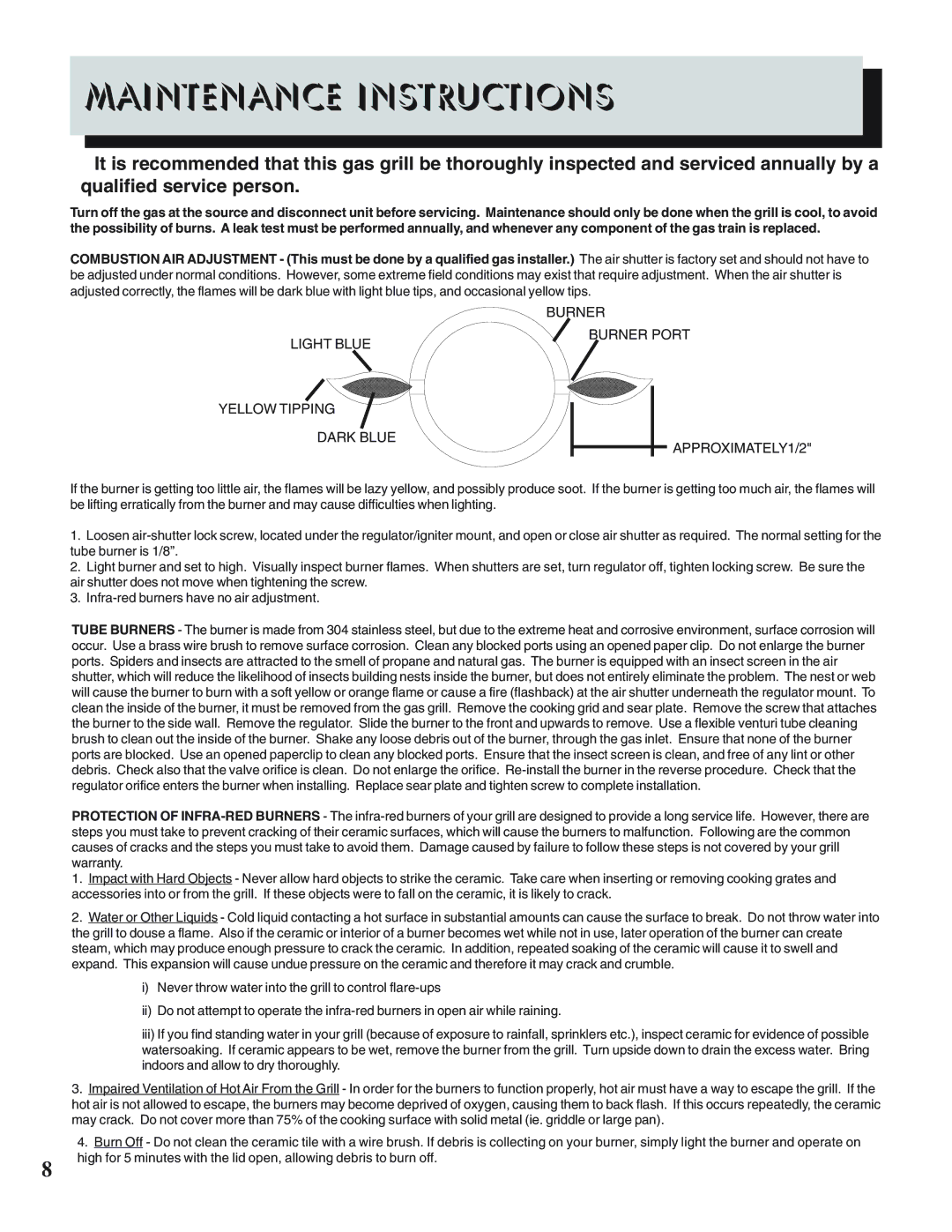
MAINTENANCE INSTRUCTIONS
It is recommended that this gas grill be thoroughly inspected and serviced annually by a qualified service person.
Turn off the gas at the source and disconnect unit before servicing. Maintenance should only be done when the grill is cool, to avoid the possibility of burns. A leak test must be performed annually, and whenever any component of the gas train is replaced.
COMBUSTION AIR ADJUSTMENT - (This must be done by a qualified gas installer.) The air shutter is factory set and should not have to be adjusted under normal conditions. However, some extreme field conditions may exist that require adjustment. When the air shutter is adjusted correctly, the flames will be dark blue with light blue tips, and occasional yellow tips.
BURNER
LIGHT BLUE
YELLOW TIPPING
BURNER PORT
DARK BLUE
APPROXIMATELY1/2"
If the burner is getting too little air, the flames will be lazy yellow, and possibly produce soot. If the burner is getting too much air, the flames will be lifting erratically from the burner and may cause difficulties when lighting.
1.Loosen
2.Light burner and set to high. Visually inspect burner flames. When shutters are set, turn regulator off, tighten locking screw. Be sure the air shutter does not move when tightening the screw.
3.
TUBE BURNERS - The burner is made from 304 stainless steel, but due to the extreme heat and corrosive environment, surface corrosion will occur. Use a brass wire brush to remove surface corrosion. Clean any blocked ports using an opened paper clip. Do not enlarge the burner ports. Spiders and insects are attracted to the smell of propane and natural gas. The burner is equipped with an insect screen in the air shutter, which will reduce the likelihood of insects building nests inside the burner, but does not entirely eliminate the problem. The nest or web will cause the burner to burn with a soft yellow or orange flame or cause a fire (flashback) at the air shutter underneath the regulator mount. To clean the inside of the burner, it must be removed from the gas grill. Remove the cooking grid and sear plate. Remove the screw that attaches the burner to the side wall. Remove the regulator. Slide the burner to the front and upwards to remove. Use a flexible venturi tube cleaning brush to clean out the inside of the burner. Shake any loose debris out of the burner, through the gas inlet. Ensure that none of the burner ports are blocked. Use an opened paperclip to clean any blocked ports. Ensure that the insect screen is clean, and free of any lint or other debris. Check also that the valve orifice is clean. Do not enlarge the orifice.
PROTECTION OF
1.Impact with Hard Objects - Never allow hard objects to strike the ceramic. Take care when inserting or removing cooking grates and accessories into or from the grill. If these objects were to fall on the ceramic, it is likely to crack.
2.Water or Other Liquids - Cold liquid contacting a hot surface in substantial amounts can cause the surface to break. Do not throw water into the grill to douse a flame. Also if the ceramic or interior of a burner becomes wet while not in use, later operation of the burner can create steam, which may produce enough pressure to crack the ceramic. In addition, repeated soaking of the ceramic will cause it to swell and expand. This expansion will cause undue pressure on the ceramic and therefore it may crack and crumble.
i)Never throw water into the grill to control
ii)Do not attempt to operate the
iii)If you find standing water in your grill (because of exposure to rainfall, sprinklers etc.), inspect ceramic for evidence of possible watersoaking. If ceramic appears to be wet, remove the burner from the grill. Turn upside down to drain the excess water. Bring indoors and allow to dry thoroughly.
3.Impaired Ventilation of Hot Air From the Grill - In order for the burners to function properly, hot air must have a way to escape the grill. If the hot air is not allowed to escape, the burners may become deprived of oxygen, causing them to back flash. If this occurs repeatedly, the ceramic may crack. Do not cover more than 75% of the cooking surface with solid metal (ie. griddle or large pan).
4.Burn Off - Do not clean the ceramic tile with a wire brush. If debris is collecting on your burner, simply light the burner and operate on
8 | high for 5 minutes with the lid open, allowing debris to burn off. |
|
